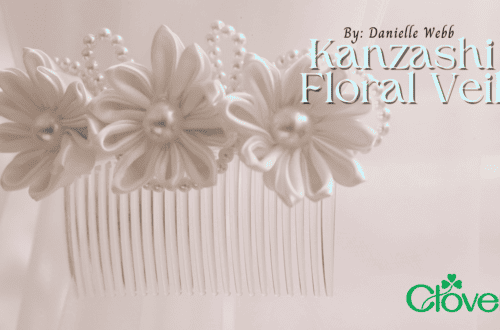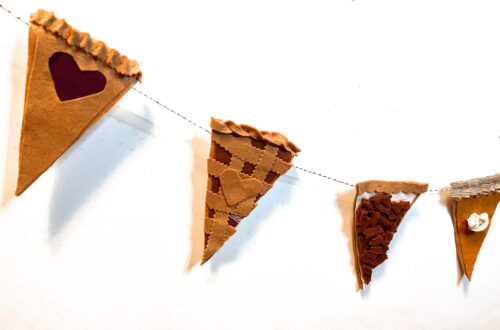Needle Felting Statement Beads (QUOE TIPS)

I have been on a big jewelry kick as of late. I’ll find myself scrolling for hours on different online shops trying to find pieces that really pack a punch and are a big statement.
Now that I have a lot of free time because of quarantine, well… let’s just say it hasn’t been great for my wallet. After a particularly large shopping spree, I knew I had to find an alternative.
That’s when I thought, Quayln, you MAKE your own wardrobe, why should your jewelry be any different? So I pulled out my jewelry making supplies, wool roving, and felting tools.
The rest, as they say, is history. I quickly found that the process of felting jewelry is simple, fast, and inexpensive! And I’ve gotten my technique down to a science. Okay, so you’re sold. Are you ready to make a statement in your own #memade jewels? Great! Here’s what we need to begin:
Supplies:
- Needle Felting Mat (Large) – Art. No 8911
- Pen Style Needle Felting Tool (+ Refill Needles) – Art. No 8901
- Felting Needle Tool (+ Refill Needles) – Art. No 8900
- Sashiko Needles (Long) – Art. No 2009
- Assorted Wool Roving
- General Jewelry Hardware/Tools
- 12 weight cotton thread or embroidery floss

Instructions:
We will be going over three main bead shapes, merging shapes, and finishing. Let’s first look at the three foundational shapes I use when creating felt jewelry.
Sphere
When creating felt beads, the obvious first choice is a typical “bead” shaped sphere. Begin by taking your roving and lightly placing it in a circular formation on the felting mat. For this shape, the direction of the fibers isn’t important.
Once placed, take your 5 prong felting tool and tamp down first around the circumference of the felt, then the middle. Remember to keep the tool perpendicular to the mat as much as possible, you’re a lot less likely to break a needle or stick yourself!


Once the roving has been tamped down and is relatively flat, begin carefully rolling the edges of the roving inward to create dimension. It is at this point you will get into finer detail, and may want to switch to the felting pen, with two or three prongs. Carefully hold down the rolled edges and begin felting them down on themselves into the middle. At this point, the felt should resemble the shape of a throw pillow.


Now, place the felt between your hands and gently roll it around, adding slight pressure for a few seconds. This will help shape the bead, slightly felt, and remove unsightly needle holes. Going back with the felting pen, felt down any imperfections and bumps around the sphere. Repeat the process of rolling and felting until satisfied with the shape.


Cylinder
Much like the sphere, begin by placing roving on the felting mat. Focus on placing the fibers in the same direction with a rectangular shape. Tamp down around the roving. Once tamped down, fold over both of the short ends of the roving and tamp those down to the middle of the work.


Now, carefully pick up the long edge closest to you and roll the roving onto itself, creating a cylindrical tube. Begin felting down the tube into a solid cylinder, focusing most on the newly formed seam. Be sure to roll the cylinder around to felt over every section. When you feel you have felted the entire piece, repeat the rolling and felting process of the finishing for the sphere until you reach the desired look.


Freeform Shapes
This style of felt jewelry is where you have the most room to play. Using the techniques laid out in the previous two shapes, you can create a multitude of curious freeform shapes. With freeform shapes, I have found the most success in flat pieces like large focal point pendants. Here I have felted a triangular shape.


Beyond the Basics
Don’t be afraid of going back in with contrast colors of roving and adding decoration to your jewelry, or of using hand-dyed roving and yarn as accents! Likewise, once base shapes are created, they can be combined in beautiful and eye-catching ways. Take the pieces below as an example. The pendant that resembles a marbled river rock is made using hand-dyed roving by Moontower Dyeworks, A decorated hemisphere and a cylinder felt together to become a mushroom. A little yarn, freeform leaves, and decorated spheres become fresh and ripe cherries. A hemisphere and a decorated freeform circle become a flying saucer, and a few strands of neon yarn become its jet beams!

Finishing
There are two main ways of finishing your jewelry. For freeform, and more flat shapes, the best thing may be to add a jump ring to the top. For more simple shapes like traditional spheres, you may find that all you need for a chic necklace is to string all of them on a cotton thread using a long type sashiko needle. These techniques, too, can be combined to create some truly unique statement jewelry!


If you follow along and create your own show-stopping pieces of ready-to-wear jewelry, be sure to tag Clover and me on Instagram to show us your beautiful work! For those of you who are fans of QUOE TIPS, be sure you keep an eye on the blog later this month, as I’ll be coming at you with a brand new technique for knitters, weavers, and crocheters to spice up their finished projects.
Until next time, break the status.

Follow what Quayln is up to next on his Blog | Instagram | Facebook | Pinterest | YouTube | Ravelry
Stay connected with Clover on Facebook | Twitter | Instagram | Pinterest | YouTube | Ravelry
[mc4wp_form id=”11289″]


